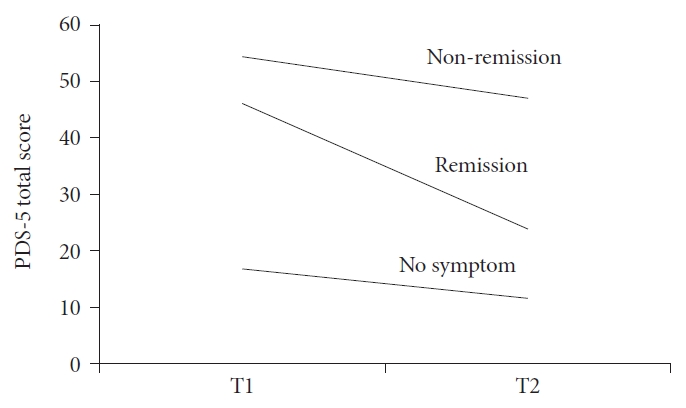3. Au TM, Dickstein BD, Comer JS, Salters-Pedneault K, Litz BT. Co-occurring posttraumatic stress and depression symptoms after sexual assault: a latent profile analysis. J Affect Disord 2013;149:209-216.


4. Khadr S, Clarke V, Wellings K, Villalta L, Goddard A, Welch J, et al. Mental and sexual health outcomes following sexual assault in adolescents: a prospective cohort study. Lancet Child Adolesc Health 2018;2:654-665.


5. Smith HL, Summers BJ, Dillon KH, Cougle JR. Is worst-event trauma type related to PTSD symptom presentation and associated features? J Anxiety Disord 2016;38:55-61.


6. Morina N, Wicherts JM, Lobbrecht J, Priebe S. Remission from posttraumatic stress disorder in adults: a systematic review and meta-analysis of long term outcome studies. Clin Psychol Rev 2014;34:249-255.


7. Chapman C, Mills K, Slade T, McFarlane AC, Bryant RA, Creamer M, et al. Remission from post-traumatic stress disorder in the general population. Psychol Med 2012;42:1695-1703.


10. Lowe SR, Ratanatharathorn A, Lai BS, van der Mei W, Barbano AC, Bryant RA, et al. Posttraumatic stress disorder symptom trajectories within the first year following emergency department admissions: pooled results from the International Consortium to predict PTSD. Psychol Med 2021;51:1129-1139.


11. Müller M, Ajdacic-Gross V, Rodgers S, Kleim B, Seifritz E, Vetter S, et al. Predictors of remission from PTSD symptoms after sexual and nonsexual trauma in the community: a mediated survival-analytic approach. Psychiatry Res 2018;260:262-271.


12. Filipas HH, Ullman SE. Social reactions to sexual assault victims from various support sources. Violence Vict 2001;16:673-692.

13. Osenbach JE, Lewis C, Rosenfeld B, Russo J, Ingraham LM, Peterson R, et al. Exploring the longitudinal trajectories of posttraumatic stress disorder in injured trauma survivors. Psychiatry 2014;77:386-397.


14. Ozer EJ, Best SR, Lipsey TL, Weiss DS. Predictors of posttraumatic stress disorder and symptoms in adults: a meta-analysis. Psychol Bull 2003;129:52-73.


15. Darves-Bornoz JM, Lépine JP, Choquet M, Berger C, Degiovanni A, Gaillard P. Predictive factors of chronic post-traumatic stress disorder in rape victims. Eur Psychiatry 1998;13:281-287.


16. Hakimi D, Bryant-Davis T, Ullman SE, Gobin RL. Relationship between negative social reactions to sexual assault disclosure and mental health outcomes of Black and White female survivors. Psychol Trauma 2018;10:270-275.


18. Dworkin ER, Ojalehto H, Bedard-Gilligan MA, Cadigan JM, Kaysen D. Social support predicts reductions in PTSD symptoms when substances are not used to cope: a longitudinal study of sexual assault survivors. J Affect Disord 2018;229:135-140.


19. Ullman SE, Townsend SM, Filipas HH, Starzynski LL. Structural models of the relations of assault severity, social support, avoidance coping, self-blame, and PTSD among sexual assault survivors. Psychol Women Q 2007;31:23-37.


20. Laffaye C, Cavella S, Drescher K, Rosen C. Relationships among PTSD symptoms, social support, and support source in veterans with chronic PTSD. J Trauma Stress 2008;21:394-401.


21. van Minnen A, Arntz A, Keijsers GPJ. Prolonged exposure in patients with chronic PTSD: predictors of treatment outcome and dropout. Behav Res Ther 2002;40:439-457.


22. Holliday R, Holder N, Surís A. Reductions in self-blame cognitions predict PTSD improvements with cognitive processing therapy for military sexual trauma-related PTSD. Psychiatry Res 2018;263:181-184.


23. Simon RI. Chronic posttraumatic stress disorder: a review and checklist of factors influencing prognosis. Harv Rev Psychiatry 1999;6:304-312.


24. Chen L, Tan H, Cofie R, Hu S, Li Y, Zhou J, et al. Prevalence and determinants of chronic post-traumatic stress disorder after floods. Disaster Med Public Health Prep 2015;9:504-508.


26. Marshall RD, Turner JB, Lewis-Fernandez R, Koenan K, Neria Y, Dohrenwend BP. Symptom patterns associated with chronic PTSD in male veterans: new findings from the National Vietnam Veterans Readjustment Study. J Nerv Ment Dis 2006;194:275-278.

30. Foa EB, McLean CP, Zang Y, Zhong J, Powers MB, Kauffman BY, et al. Psychometric properties of the posttraumatic diagnostic scale for DSM5 (PDS-5). Psychol Assess 2016;28:1166-1171.


32. Zohar J, Amital D, Miodownik C, Kotler M, Bleich A, Lane RM, et al. Double-blind placebo-controlled pilot study of sertraline in military veterans with posttraumatic stress disorder. J Clin Psychopharmacol 2002;22:190-195.


33. Brady K, Pearlstein T, Asnis GM, Baker D, Rothbaum B, Sikes CR, et al. Efficacy and safety of sertraline treatment of posttraumatic stress disorder: a randomized controlled trial. JAMA 2000;283:1837-1844.


34. Felitti VJ, Anda RF, Nordenberg D, Williamson DF, Spitz AM, Edwards V, et al. Relationship of childhood abuse and household dysfunction to many of the leading causes of death in adults. The Adverse Childhood Experiences (ACE) Study. Am J Prev Med 1998;14:245-258.

36. Carlson EB, Putnam FW. An update on the dissociative experiences scale. Dissociation: Prog Dissociative Disord 1993;6:16-27.
37. Kim D, Lim H, Roh S. Factor structure of Korean Dissociative Experiences Scale (KDES-II) among psychiatric patients. J Korean N europsychiatr Assoc 2007;46:136-143.
38. Radloff LS. The CES-D scale: a self-report depression scale for research in the general population. Appl Psychol Measur 1977;1:385-401.
39. Jeon G, Choi S, Yang B. Integrated adaptation of CES - D in Korea. Korean J Health Psychol 2001;6:59-76.
40. Beck AT, Epstein N, Brown G, Steer RA. An inventory for measuring clinical anxiety: psychometric properties. J Consult Clin Psychol 1988;56:893-897.


41. Yook SP, Kim ZS. A clinical study on the Korean version of Beck Anxiety Inventory: comparative study of patient and non-patient. Korean J Clin Psychol 1997;16:185-197.
42. Campbell R, Raja S. The sexual assault and secondary victimization of female veterans: help-seeking experiences with military and civilian social systems. Psychol Women Q 2005;29:97-106.


43. Ullman SE. Psychometric characteristics of the Social Reactions Questionnaire: a measure of reactions to sexual assault victims. Psychol Women Q 2000;24:257-271.


44. Shim K, Ahn H. A validation of the Korean version of the Social Reactions Questionnaire. Korean J Counsel Psychotherapy 2014;26:271-298.











